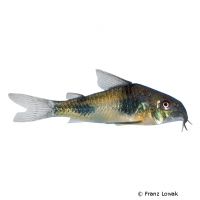Ehrhardt's Corydoras (Corydoras ehrhardti)
| Ehrhardt's Corydoras Corydoras ehrhardti | |
|---|---|
| Name | Ehrhardt's Corydoras |
| Name Lat. | Corydoras ehrhardti |
| Synonym | Corydoras meridionalis |
| Family | Armoured Catfishes |
| Family lat. | Callichthyidae |
| Order | Catfishes |
| Order lat. | Siluriformes |
| Origin | Brazil |
| Habitat | Tributaries, streams |
| Diet | Omnivore |
| pH | 6.5-7.5 |
| Behavior | Peaceful |
| Keeping | Group |
| Care Level | Moderate |
| Reproduction | Substrate spawner |
| Breeding | None reported |
| Life Span | 3-5 years |
| Protection | No |
| Metric Units | |
| Size | 4-5 cm |
| Temperature | 19-22 °C |
| Hardness | 5-15 °dH |
| Aquarium | ~ 100 l |
| US Units | |
| Size | 1.6"-2" |
| Temperature | 66-72 °F |
| Hardness | 89-267 ppm |
| Aquarium | ~ 25 gal |
Distribution and habitat
The distribution area of the Erhardt's Cory Catfish is the Rio Iguacu river system and coastal rivers in Santa Catarina and Paraná (Brazil). They live there in shallow, slow-flowing waters with sandy, silty bottoms covered with dead wood, branches and leaves.
Maintenance
The aquarium should have dense planting with shady hiding places (roots). In order not to injure their barbels (serve for orientation and foraging), a soft, sandy substrate is ideal, which should be covered with some mulm and foliage (e.g. sea almond leaves).
No ammonia, ammonium and nitrite should be detectable, the nitrate value should not exceed 100 mg/l. To ensure the water quality and oxygen content, a filter and heater adapted to the aquarium size is required, as well as lighting for the species-appropriate day-night rhythm of the animals.
Diet
They prefer live food, such as daphnia, cyclops, artemia, mysis, mosquito larvae or tubifex, which are also accepted without problems in frozen form, plus commercially available, frozen special food mixtures, supplemented with high-quality dry food for catfish (tablets, granules, pellets) with vegetable components (e.g. spirulina, kelp).
Regular and varied feeding promotes health and prevents deficiency symptoms. Only feed as much as is eaten immediately (in a maximum of 10 minutes).
Behaviour and compatibility
They are peaceful and sociable fish that live in groups and can be kept well in a community tank with other peaceful fish. At least 5, but preferably more Erhardt's Corydoras should be kept together
Basically, only compatible fish species with similar requirements for water conditions and water temperature should be socialized.
Sex dimorphism
The sexes are difficult to distinguish. The females are slightly larger and more plump when seen from above.
Reproduction and breeding
During mating (T-position), the eggs enter a pocket formed by the ventral fins of the female and, after fertilization, are glued to substrates (e.g. leaves, stems). This process is repeated a few times. The larvae hatch after about 2-3 days and swim freely after 2-5 days.
There are no known reports of successful breeding in the aquarium.
Important
They have additional intestinal respiration to survive in oxygen-poor waters and sometimes come to the water surface for air even in the oxygen-rich aquarium.
When catching them, use nets with as fine a mesh as possible to prevent the hard rays of the pectoral fins from becoming entangled, which can cause painful puncture wounds when touched
Temperatures above 24 °C are not tolerated in the long term.
The well-being of the fish should be checked regularly. The temperature should be checked daily, the pH value, hardness and nitrate value at least every 14 days. Regular partial water changes are recommended, even if the contaminant level has not yet reached the upper limit. Sudden changes in water quality should be avoided. Newly introduced fish must be accustomed slowly to the water in the aquarium.
Further literature can be found in your pet store.
References
Text: petdata; Image: Franz Lowak
Source: BMELV (1998): Tierschutzgutachten - Haltung von Zierfischen (Süßwasser); BAENSCH & RIEHL (2004): Aquarien Atlas Bd. 2, Mergus Verlag; ENGELMANN (2005): Zootierhaltung - Tiere in menschlicher Obhut: Fische, Verlag Harri Deutsch
- Gemäß § 21 Abs. 5 Tierschutzgesetz idgF
